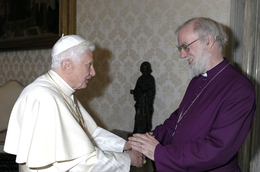Archbishop and Pope to pray together during Rome visit
 Pope Benedict XVI and Archbishop Rowan Williams
Pope Benedict XVI and Archbishop Rowan WilliamsFriday 9th March 2012
Archbishop Rowan Williams and Pope Benedict XVI will lead evening prayer together at the Church of San Gregorio Magno al Celio on Saturday 10 March, as part of a visit to Rome by the Archbishop this weekend.After a private meeting earlier in the day, the Archbishop and the Pope will travel to San Gregorio to join the resident monastic Community there for Vespers (evening prayer), during which the Archbishop and the Pope will each deliver a homily, and light candles together in the Chapel of St Gregory the Great. Read the text of the Archbishop’s homily here.
The occasion forms part of the celebrations of the 1,000th anniversary of the Camaldolese (Benedictine) monastic family, who invited the Archbishop to travel to Rome to join the celebrations in recognition of the close connection of San Gregorio with the Church of England and the Anglican Communion. The ancient Roman monastery on the Caelian Hill which bears the name of Pope St Gregory the Great was the place from which Gregory (himself a monk) sent St Augustine of Canterbury and a party of fellow Benedictine monks to Britain in the late 590s. (See below for a short history.) The Camaldolese (whose mother house is near Arezzo) have occupied the monastery buildings at San Gregorio since 1573.
Saturday’s Vespers marks the third time in recent decades that the Bishop of Rome and the Archbishop of Canterbury have shared a liturgical celebration in this historic setting. The previous occasions were both during the pontificate of Pope John Paul II - during the September 1989 visit of Archbishop Robert Runcie, and the December 1996 visit of Archbishop George Carey.
On Sunday morning 11 March the Archbishop will celebrate and preach at a Eucharist at St Paul’s ‘within the walls’, Via Nazionale, for the Anglican parishes in Rome. Read the text of the Archbishop's sermon here, or view the video.
In the afternoon he will return to San Gregorio Magno to continue the millennial celebration of the Camaldoli at a conference where he will deliver an address entitled ‘Monastic Virtues and Ecumenical Hopes’. Archbishop Rowan will speak alongside Father Robert Hale, Prior of the New Camaldoli Hermitage in Big Sur, California. Read the text of the Archbishop's address here.
On Monday 12 March (until recent decades the feast of St Gregory) the Archbishop will travel to visit the monastic Community at the Abbey of Monte Cassino, founded by St Benedict around 529, where he will be present at Vespers and will give an address on ‘Monks and Mission: a perspective from England’. Read the text of the Archbishop's address here.
St Gregory and the British Church
The history of Pope Gregory’s initiative is captured in this extract from Anglicanism and the Western Christian Tradition: Continuity and Change - the text of a Vatican Library Exhibition 2002:
2 The Re-evangelisation of England
Christianity existed in England from earliest times as the martyrdom of St Alban bears witness. But after the collapse of the Roman province of Britannia, it was driven to the margins as paganism reasserted itself. Then in the 7th century Irish-Celtic missionaries, whose lives and evangelical careers were characterized by ascetic spirituality and heroic endeavour, made widespread and vigorous efforts to bring the faith to the small and mutually hostile Anglo-Saxon kingdoms. Their influence extended as far as East Anglia, where c.630 St Fursey established a monastic community at Burgh Castle under the patronage of the Christian king, Sigebert. Later, after the death of Sigebert, he moved on to work in Gaul.
The other, and ultimately more significant, evangelical drive originated with Pope Gregory the Great in Rome, who sent St Augustine to England. When St Augustine landed in Kent in 597, he was implementing the last phase of a grand strategy designed to reconvert all the old provinces of the Roman Empire. This was masterminded by popes who were effectively the heirs of Caesar as well as of St Peter. Pope Gregory represents in his own person the great strength of the Roman Church. His writings show him to have been a man of deep spirituality, but also an organiser and governor, imbued with the best traditions of Roman administration so admired by the Germanic tribes which had colonised the Empire.
The story of the re-conversion of the Anglo-Saxon kingdoms is told by the Venerable Bede in his Ecclesiastical History. It was not achieved without some dramatic setbacks, but by the end of the seventh century, Christianity had become established at all the royal courts, and from there it gradually radiated outwards across the countryside. In East Anglia it was the Burgundian Felix, acting in close association with Canterbury, and therefore with Rome, who made the lasting impression. His see was established at ‘Dummoc’, now believed to be Felixstowe.
Gregory the Great had instructed Augustine to establish two ecclesiastical provinces in Britannia, based on London and York. Each was to have twelve bishoprics. This neat plan did not correspond with political reality on the ground and, because of the initial success of St Augustine at the Kentish court, Canterbury came to replace London. In 663/4 a synod at Whitby, accepting that the pope as the successor of St Peter held the keys to the kingdom of heaven, decided that the Roman calendar, liturgy and institutional structure should prevail over the Celtic ones.
